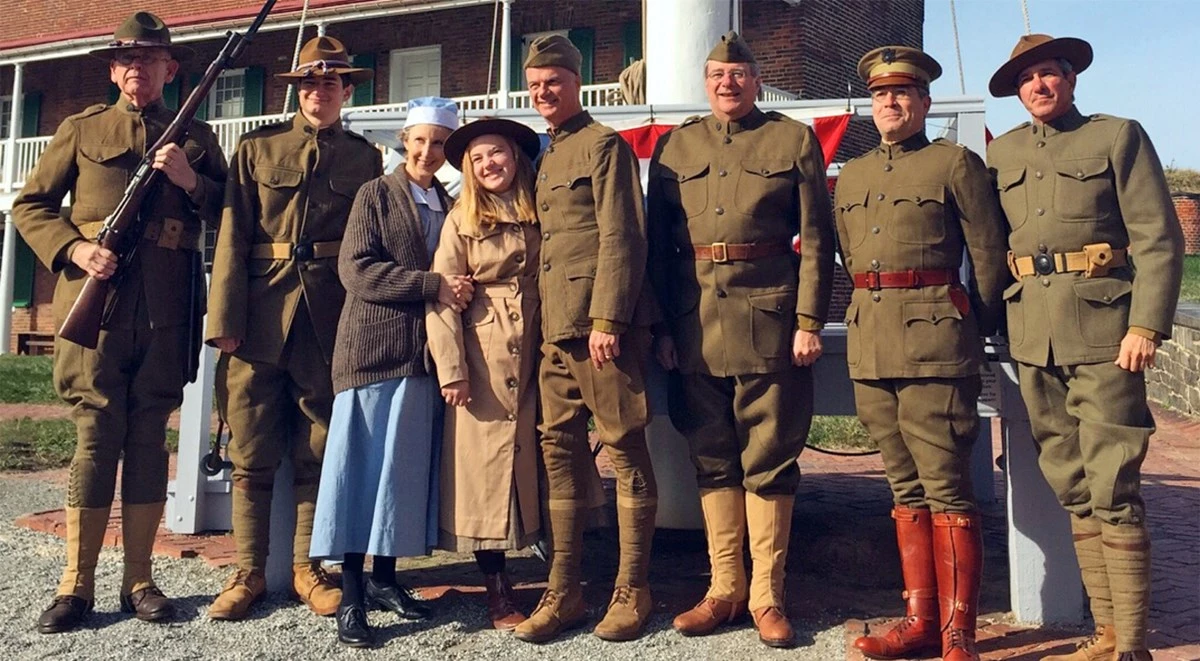Last updated: January 2, 2018
Article
Unpacking History From an Old Kit Bag: Armistice Day at Fort McHenry

NPS photo
On Veterans Day at Fort McHenry NMHS nearly 500 visitors discovered the World War I origins of the holiday by raising a 48-star flag above the fort, observing a moment of silence at the eleventh hour on the eleventh day of the eleventh month, and exploring some hands-on history exhibits in our World War I Centennial Room staffed by rangers and living history volunteers. Wearing uniforms of the U.S. Army Medical Corps, interpreters discussed Fort McHenry’s busiest era of military service, describing not the bombs and rockets of the War of 1812, but rather the medical advances of the First World War during which an expansive 3,000 bed hospital was constructed to receive and treat the wounded returning from the Western Front. The advent of trench warfare, expanding use of machine guns, tanks, and chemical weapons brought new challenges to Army medical staff. The doctors, nurses, and corpsmen of General Hospital No. 2 met and mastered these challenges by pioneering new methods in reconstructive maxillofacial surgery, occupational therapy, and approaches to treating post-traumatic stress disorder.
Fort McHenry volunteers Dave Cole and Brian Alexander generously shared their extensive knowledge and personal collections of original World War I artifacts and accoutrement with visitors in our recreated offices of General Hospital No. 2. As the clickety-clack of an original typewriter, whirring ring of a candlestick phone, and songs from the Victrola filled the room visitors thumbed through photographs, postcards, Army requisitions, and advertisements from the Great War era. Parents and children alike practiced knitting and weaving as our living history nurses and reconstructive aides described the vital work performed in the occupational therapy department to help men regain their motor skills and return to civilian life. New “recruits” could try on original equipment and handle the items once carried by Army medics and soldiers in the trenches and on the home front. Though the buildings of General Hospital No. 2 were demolished in the 1920s and nearly a century has passed since the first of over 20,000 patients arrived, our visitors spent some time immersed in the sights, sounds, and stories of the Lost Generation that fought the “war to end all wars.” Connecting with the everyday items used by those men and women whose photographs are featured in our offices and newly installed World War I exhibit, helped visitors to remember the service of those who fought as well as those who helped many return to their lives, rebuilt and renewed in body, mind, and spirit after the guns were finally silenced in November 1918.
By Shannon McLucas
Fort McHenry volunteers Dave Cole and Brian Alexander generously shared their extensive knowledge and personal collections of original World War I artifacts and accoutrement with visitors in our recreated offices of General Hospital No. 2. As the clickety-clack of an original typewriter, whirring ring of a candlestick phone, and songs from the Victrola filled the room visitors thumbed through photographs, postcards, Army requisitions, and advertisements from the Great War era. Parents and children alike practiced knitting and weaving as our living history nurses and reconstructive aides described the vital work performed in the occupational therapy department to help men regain their motor skills and return to civilian life. New “recruits” could try on original equipment and handle the items once carried by Army medics and soldiers in the trenches and on the home front. Though the buildings of General Hospital No. 2 were demolished in the 1920s and nearly a century has passed since the first of over 20,000 patients arrived, our visitors spent some time immersed in the sights, sounds, and stories of the Lost Generation that fought the “war to end all wars.” Connecting with the everyday items used by those men and women whose photographs are featured in our offices and newly installed World War I exhibit, helped visitors to remember the service of those who fought as well as those who helped many return to their lives, rebuilt and renewed in body, mind, and spirit after the guns were finally silenced in November 1918.
By Shannon McLucas
